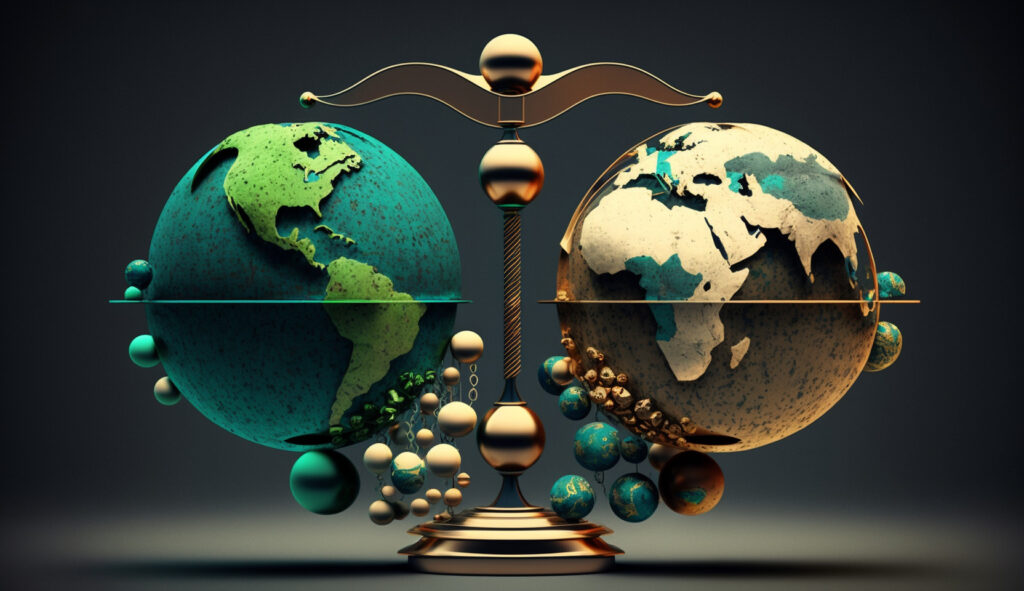
Just as we experience the thrill of a roller coaster, we face the ups and downs of the business cycle in economies. Our article delves deep into the intriguing fluctuations of economic cycles, their stages, and their implications. We explore how business cycles manifest in varied economic frameworks, how they influence financial markets, and the crucial indicators we use to identify each cycle’s phase. As decision-makers, investors, and business owners, this understanding allows us to navigate economic changes and devise effective strategies, turning intimidating business cycles into journeys we can confidently navigate.
What Is the Business Cycle?
In the world of economics, change is a constant reality. In fact, an economy doesn’t always grow at the same pace. Instead, it experiences ups and downs, similar to the waves in the sea. This rise and fall motion is what we call the business or economic cycle. To put it simply, it’s a lot like the thrills of a roller coaster ride.
Let’s hop on this roller coaster ride. First and foremost, we encounter the phase known as economic expansion. It feels like we’re steadily climbing the roller coaster track in this period. The economy is on an upward trend, meaning more goods are produced, more jobs are available, and more overall business activity is happening. As a result, businesses typically flourish. The number of people out of work goes down. The total income of the country, known as the GDP, rises. As this happens, people feel more confident and spend more money. It’s a cheerful and bustling time, much like the atmosphere of a lively amusement park on a sunny day.
After the climb, we reach the roller coaster’s highest point. We call this the peak. The economy is at its strongest, and everything is at its highest level. However, just like a roller coaster that can’t stay at its peak forever, the economy also can’t remain at its peak indefinitely. This top point signals a significant change. We’re transitioning from an expanding economy to a contracting one.
Following the peak, much like a roller coaster that takes a sudden drop, the economy also starts its decline. This phase is known as the contraction phase. The once vibrant amusement park now feels quieter. The economy begins to slow down, with fewer goods being produced and fewer jobs available. Business activities decrease, more people are out of work, and businesses may experience challenging times. The exhilaration experienced at the peak rapidly changes to concern as the economy slows down.
Eventually, the roller coaster completes its descent. We reach the lowest point, or what we call the trough. This point signifies the end of the economy’s downward slide. From here, it’s time for the economy to grow again. After hitting this bottom point, the economy improves and enters the next growth phase. It’s similar to a roller coaster that begins to climb again after a steep drop.
Understanding these business cycles is extremely important, especially for people who make significant decisions, such as government officials and business owners. Various factors influence these economic waves, including government policies, financial conditions, price fluctuations, business investments, and consumer behavior. With a solid grasp of these cycles, decision-makers can plan more effectively, mitigate risks, and seize opportunities. This knowledge aids in ensuring a smoother journey on the economic roller coaster.
In conclusion, the business cycle narrates the story of an economy’s life. It’s a tale of growth and contraction, prosperous and challenging times. By comprehending and learning from this story, we are better equipped to navigate changes. Thus, we can confidently ride the ups and downs of the business cycle.
How Business Cycles Show Up in Different Economies?
Business cycles, or the ups and downs in an economy, are everywhere. They happen in all kinds of economies. But we usually talk about them in market-oriented or capitalist economies. In these economies, the forces of supply and demand decide what goods and services get produced, distributed and how they are priced. Now, let’s take a look at how business cycles work in different economies.
Capitalist Economies
In a capitalist or free market economy, business cycles are like the changing seasons – they are a part of life. The economy grows and prospers, then it slows down and contracts. This is like a roller coaster ride. It goes up during times of growth and goes down during economic slowdowns. This up-and-down pattern is what we call a business cycle.
Mixed Economies
Next, we have mixed economies. Here, we see bits of free market economies and command economies. In mixed economies, both the government and private companies have a say in the economy. The government can step in to ease the effects of a business cycle. But, actions of the private sector can still cause the economy to go up and down.
Even though the government can soften the blow of these ups and downs, it can’t get rid of them completely. So, mixed economies also experience business cycles. But, the government can help to lessen the impact.
Command Economies
In theory, command or planned economies should be safe from business cycles. Here, the government is in charge. They make long-term plans to keep production and distribution steady. The idea is to avoid big swings and keep things smooth.
However, even these economies can face ups and downs. Policy changes, planning mistakes, or outside influences can cause these swings. These might look like business cycles, but we don’t usually call them that in command economies.
So, to wrap up, all economies experience ups and downs. Whether you’re in a free market, mixed, or command economy doesn’t matter. You’ll see these cycles. But how they show up and managed can be very different. Each economy has its own way of riding the waves of business cycles.
How Does It Influence Financial Markets?
So, you now know you know what the business cycle is and what phases it consists of. Btw, did you like our roller coaster analogy? Let us know in the comments below:). As you can imagine, each business cycle phase impacts financial markets and economies uniquely. Now, let’s break down how each phase impacts these markets.
The Rising Tide of Expansion
First, let’s talk about expansion. This is when the economy is on the up and up. Businesses are making money, fewer people are jobless, and consumers are spending more. Sounds great, right? And it is! Especially for stock prices. Higher corporate earnings tend to pump up equity values.
But what about bonds, you ask? Investors might want less of them during expansion. They’re busy chasing higher returns in stocks. This means bond prices can drop, and their yields or interest rates increase. Furthermore, commodities like oil or gold might also get pricier due to higher demand.
It’s All Downhill from Here
Next, we reach the peak. This is the high point of economic expansion. Assets may become overvalued here. That’s because everyone is feeling optimistic and buying up stocks. But here’s the catch – inflation usually creeps up during this phase. If it gets too high, central banks might hike up interest rates. These higher rates make borrowing more expensive, slowing down the economy and hitting corporate profits. And that can lead to stock prices dropping.
The Slowdown of Contraction
As we move on, we enter contraction or recession. This is when economic growth slows down, companies make less money, and more people lose their jobs. It’s not a happy time and especially bad for stock prices. With companies earning less, equity values go down.
So, what do investors do? They usually look for safer places to put their money. This means they might buy more bonds. This drives up bond prices and pushes down their yields. Also, commodity prices might drop because of less demand.
The Bottom of the Trough
Finally, we hit the trough. This is the lowest point of a recession. Asset prices might be undervalued here, so some investors might start buying, hoping for the next expansion phase. But it’s tricky to time it right. A lot of investors stay careful until there are clear signs of recovery.
Remember, the business cycle isn’t the only thing influencing financial markets. There are a lot of other factors in the mix – like changes in technology, events around the world, and shifts in consumer behavior. Also, the financial markets can influence the business cycle too. It’s a complex dance of different factors that keeps the world of finance spinning.
Figuring Out the Ups and Downs in Our Economy: A Simple Guide
To tell where we are in this cycle, economists look at a bunch of different signs. Let’s talk about these signs and what they tell us about where we are in the cycle.
Gross Domestic Product (GDP): This is a fancy way of saying the total value of everything we make and do in our country at a certain time. When GDP is growing, our economy is on the upswing. But when GDP starts to fall, it’s a sign we might be heading into a rough patch.
Employment Data: We also look at how many people have jobs. If more people are working, that’s a good sign we’re in a growth phase. But if more people are out of work, it could mean we’re heading into a slowdown.
Industrial Production: This is all about how much stuff we make in factories and mines and how much power our utilities produce. When production is up, it usually means we’re growing. But we could be in for a slowdown when it starts to fall.
Retail Sales: If people spend a lot at stores, it’s a good sign we’re growing. But if they’re tightening their belts, it could mean a slowdown is coming.
Inflation Rates: If prices are rising fast, it could mean we’ve hit the top of the cycle and might start slowing down. But if prices aren’t rising much, we might be heading into a slowdown.
Interest Rates: These are what it costs to borrow money. If the cost is getting lower, it usually means we’re in a slowdown. But if it’s getting higher, it could mean we’re growing.
Stock Market Performance: This can be tricky because the stock market can be volatile. But generally, if the market is doing well, it’s a good sign we’re growing. If it’s down, it could mean a slowdown.
Housing Market: We also look at how many houses are selling and how much they’re selling for. If there’s a lot of activity and prices are up, it’s a good sign we’re growing. But if things are quiet and prices fall, it could mean a slowdown.
Business Confidence: This is how optimistic business leaders are about the economy. It usually means we’re in a growth phase if they’re feeling good. But if they’re worried, it could mean we’re heading for a slowdown.
Organizations like the National Bureau of Economic Research (NBER) in the U.S. look at all these signs to officially say when we entered a new phase of the cycle. But this can be tricky because sometimes the signs don’t all agree, and sometimes the data changes.
Understanding these signs and what they mean for our economy’s ups and downs is super important. It can help everyone, from big investors to small business owners, make smart decisions.
Bottom Line
In wrapping up, the world of economics is like a fascinating roller coaster ride filled with ups and downs. These are business cycles, marking periods of economic growth and contraction. And just like roller coaster enthusiasts know their rides, understanding these cycles is crucial for everyone, from major policymakers to small-scale entrepreneurs.
We look at different telltale signs to get a grip on these cycles. The total worth of everything we produce and do (GDP), job availability, factory production, shopping trends, price changes, borrowing costs, stock market performance, housing market activities, and even the mood among business leaders – these all provide hints about where we are on the economic roller coaster. Sure, it can be tricky. Sometimes the signs don’t agree with each other or the data changes.
Despite the challenge of pinpointing the exact phase due to occasionally conflicting signals or revised data, organizations like the National Bureau of Economic Research (NBER) make it their job to officially determine when we transition into a new phase of the cycle.
So, the key takeaway here is to stay aware and informed. Knowing these indicators and what they signify is invaluable no matter where we are on this ride. It empowers us to make well-informed decisions, manage risks, and even grab opportunities when they come. Essentially, it gears us up for a smoother and smarter journey on this economic roller coaster ride. So hold tight, keep your eyes open, and enjoy the ride!
Did you find our article informative? Don’t forget to explore our other pieces for more insights. We’d love to hear your thoughts about this article in the comments section below.
Do The Smart Thing. Subscribe!
Get notified about our new articles and insights.




